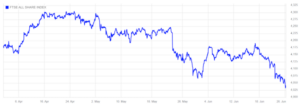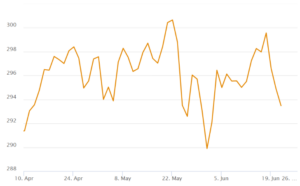While some economies across the world showed signs of recovery, inflation still remained high in Q2 2023, with central banks still maintaining high interest rates to help fight inflation.
While the Organisation for Economic Cooperation and Development (OECD) stated that the global economy began to improve in Q2, it suggested that the recovery was likely to be weak, with its outlook projecting a moderation of global Gross Domestic Product (GDP) growth from 3.3% in 2022 to 2.7% in 2023, with a pick-up to 2.9% in 2024.
Across the globe, lower energy prices slightly eased the strain on household budgets, and consumer sentiment and demand slowly started to recover. In addition, the re-opening of China provided a slight boost to global activity.
Read on to discover how the UK, European, US, and Asian markets performed between April 2023 and June 2023, and some factors contributing to the performance of the markets.
UK
Despite a slight fall, inflation remained high in Q2, with the Consumer Prices Index (CPI) slightly dropping to 8.7% in May. In a bid to combat inflation, the Bank of England (BoE) raised interest rates in June, increasing the base rate by 0.5 percentage points to 5%.
The BoE’s Monetary Policy Committee (MPC) does expect the UK inflation rate to “fall sharply from April” to around 5% by the end of 2023.
Data released by the Office for National Statistics in June revealed that both employment and unemployment rates had increased between February and April 2023 compared to the previous quarter. The UK’s employment rate was estimated to be at 76%, which was 0.2 percentage points higher than the previous quarter, while the unemployment rate was estimated to be at 3.8%.
As you can see from the graph below, UK equities were hit by weak commodity prices, with the FTSE All-Share beginning April at 4,183.73 and dropping to 4,038.26 by 26 June.

Source: London Stock Exchange
Europe
Based on figures released by Eurostat, the annual inflation rate for the Euro area decreased from 7% in April to 6.1% in May, while the European Union annual inflation rate dropped one percentage point to 7.1%.
The lowest annual rates were registered in Belgium, Denmark, Spain, and Luxembourg, with the highest annual rates recorded in Poland, the Czech Republic, and Hungary.
Despite the slight average declines in inflation, in June, the European Central Bank (ECB) introduced a 0.25 percentage point increase in interest rates, with the deposit rate rising to 3.5%.
The back-to-back monthly falls in car registrations and barely improving consumer confidence suggested a continued weakness in goods demand across Europe. Meanwhile, the unemployment rate decreased slightly in the Euro area, reaching a new record low of 6.5% in April.
Additionally, the MSCI European Index fluctuated between 1 April and 26 June, seeing a slight overall increase, as you can see from the graph below.

Source: MSCI Europe
US
May saw the US’s inflation rate fell to its lowest annual rate since March 2021. It increased just 0.1% for the month, bringing the annual level down from 4.9% in April to 4% in May.
Although the Federal Reserve left interest rates unchanged at its policy meeting in June, further rate increases were expected to come later in 2023.
In Q2, there were stronger than expected housing starts, employment numbers, and auto sales, suggesting that GDP was continuing to grow.
While Republicans and Democrats struggled to reach a compromise over the debt ceiling in May, by June, a deal to lift the ceiling had been passed through the House of Representatives and was likely to secure the support of the Senate.
Despite the bouncing inflation rates and the drama in the House of Representatives, equities remained relatively resilient, with the S&P 500 rising by 0.4% in May.
Asia
Following a strong Q1 and the end of its “zero-Covid” policy, China revealed a slowdown in activity in April.
The People’s Bank of China (PBOC) predicted that year-on-year GDP would be relatively high in Q2, mainly due to the base effects, with the CPI expected to gradually pick up in the second half of 2023 and be above 1% year-on-year by December.
In May, the MSCI Asia ex-Japan index lost around 1.8%, with weakening demand for Chinese manufacturing potentially a factor. In fact, weak economic data from China increased worries about a global slowdown.
Meanwhile, in Japan, forecasters expected real GDP to grow at an annual rate of 1.2% in Q2, with growth of around 1% later in the year. Additionally, predictions suggested that the core CPI would increase to 3.24% in Q2.
With the TOPIX rising 3.6% in May and outperforming other developed equity markets, investors were becoming optimistic that Japan was moving away from the deflationary stagnation of the past. However, developments in overseas economic activity and prices, in addition to the situation surrounding Ukraine, are causing uncertain predictions for Japan’s economy.
Get in touch
If you need advice on any aspect of our Q2 investment update, please get in touch. Email admin@stonegatewealth.co.uk or call 01785 876222.
Please note
This blog is for general information only and does not constitute advice. The information is aimed at retail clients only.
The value of your investment can go down as well as up and you may not get back the full amount you invested. Past performance is not a reliable indicator of future performance.


 Production
Production
